
2015 Shimano XTR 11-Speed
Hit a prizefighter enough times in the mouth, and you’d better be ready for him to get up and start slugging you back. This morning the fighter in blue started counterpunching, landing key blows and beginning the long fight out of the corner.
Shimano’s XTR 2015 has finally arrived. It was worth the wait.
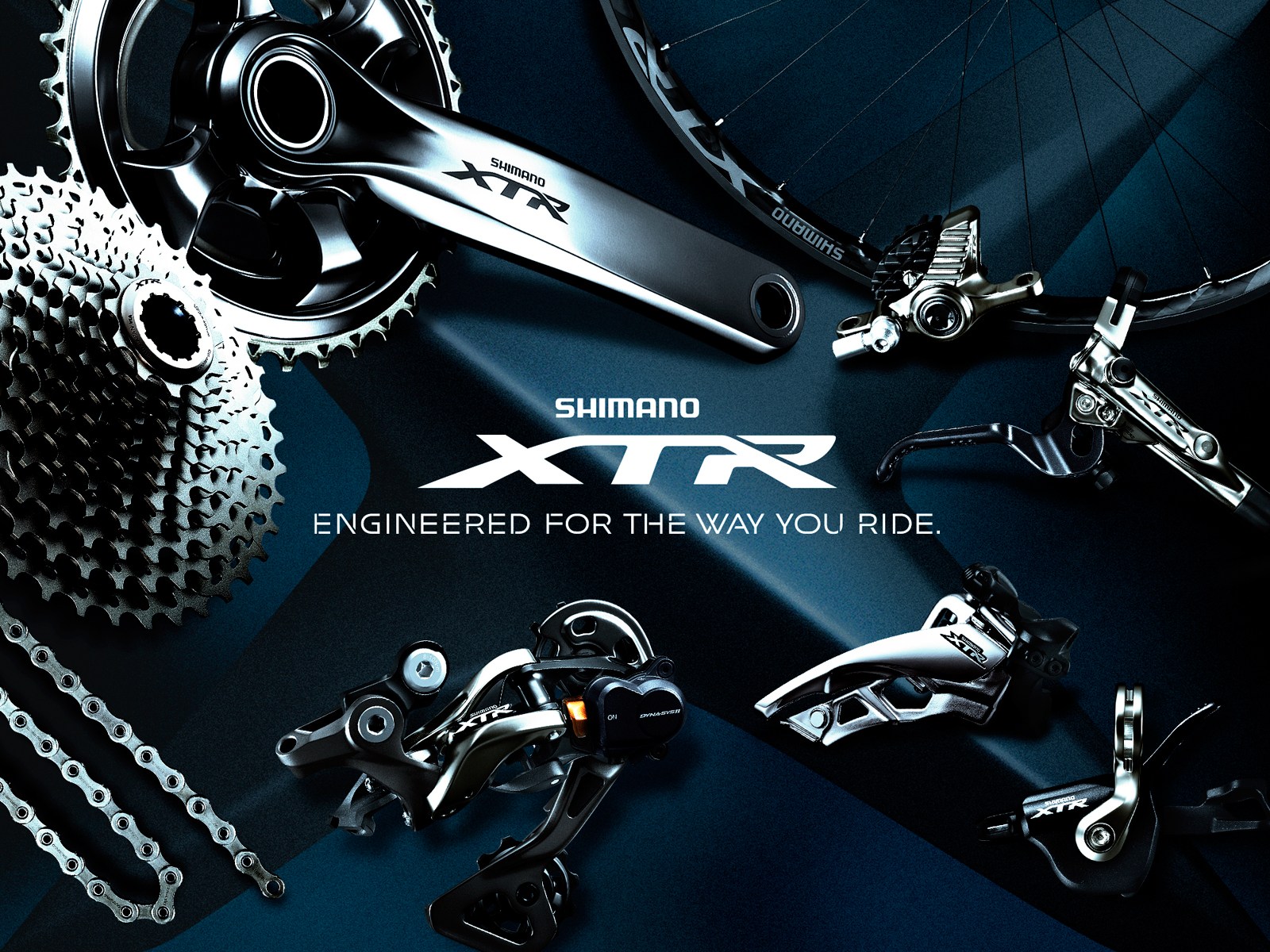
Somewhere there must be a very, very long hallway where all of these Shimano gruppo posters are displayed all in a row. Twenty two years later, they still look pretty much the same.
Unsurprisingly, we were shown 11 speed, a new single chainring configuration, and some incremental and larger than incremental improvements to every element in the drivetrain, braking system, and wheelsets. Surprisingly, the engineering superpower from Osaka didn’t take direct aim at SRAM’s 10-42 rear cluster, opting instead for an 11-40 that doesn’t require any fancy free hub footwork, but brings the pain in other ways instead. In other words, we didn’t get any shadow-boxing out of Shimano; they’re going their own way and they have the stories to back up their reasoning.
In a nutshell: Shimano have introduced a viable 1x system, and concede that it is the right choice for some riders (XC racers and riders in rolling terrain that don’t need a granny). However, the larger message is that they feel that the vast majority of the MTB market still needs (and should want – even if they don’t think they do) a double chainring – or even a triple in certain situations.

The new XTR is still so new it’s hard to find on a complete bike anywhere. Shown here is the M9000 Race group.
Shimano’s new XTR group is divided as before into Race (M9000) and Trail (M9020) designations, which are interchangeable with each other, as in the past version. The design theme for the new groups is “Rhythm and Range” which should be easy enough to understand, but we’ll delve into that a bit later. The new technologies being introduced are 11-speed cassettes and gear ratios that conform to what Shimano are calling Rhythm Step, which is gear steps of as close to 12.5% as possible. Otherwise, there are some impressive new technologies being introduced to their wheels and in a few other places, and some incremental improvements that all add up to a much improved flagship MTB group for the blue team from Shimano.
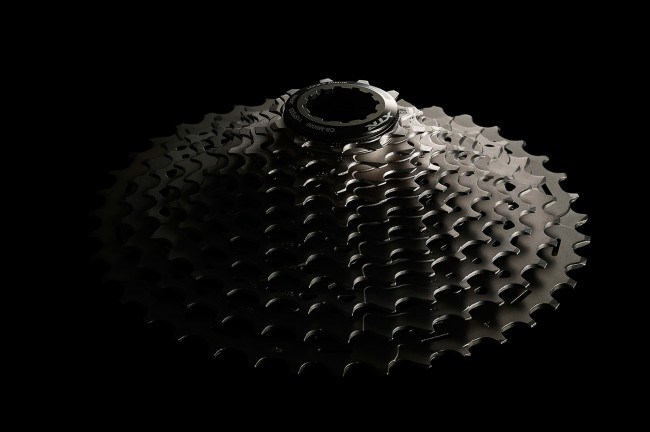
The heart of XTR 11-speed has the same 11-40 Rhythm Step tooth configuration for both the Race and Trail groups: 11, 13, 15, 17, 19, 21, 24, 27, 31, 35, 40. It rides on multi-spider carbon carriers, has Titanium, Aluminum, and Steel cogs, and is compatible with current 10-speed free hub bodies.
So what the hell is Rhythm Step? Shimano put a lot of effort into optimizing gear spacing because getting it right helps riders get the best “miles per burrito” by giving them good control over their cadence and effort. Why did they settle on a 12.5% gear ratio target? Because that’s the gear differential that translates to a 10 RPM difference (up or down) with one shift aka a ‘cadence adjustment’. Two shifts or 20 RPM = a rider’s reaction to a typical terrain change, and three shifts, or 30 RPM, is what they call a ‘reaction shift’. Rhythm Step applies to the front chainrings as well: the largest differential between any two chain rings is 10 teeth, reducing the chance of becoming bogged down or spinning out when shifting up front.
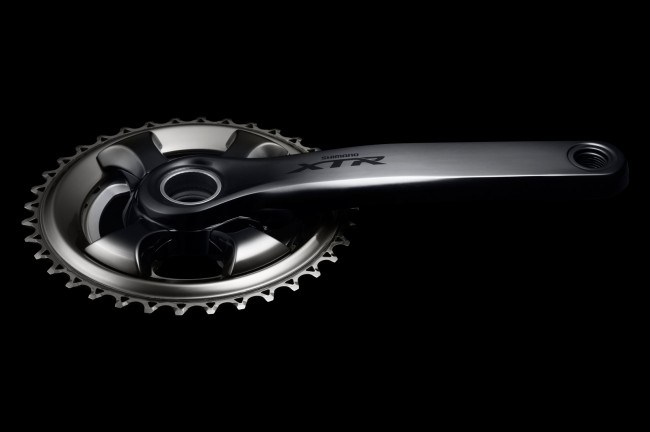
Love ’em or hate ’em, there’s a crapton of tech going on up in there. Chain ring configurations: Single (30T, 32T, 34T, 36T), double (34-24T, 36- 26T, 38-28T), triple (40-30-22T). Rather than some variation of a narrow wide chain ring, Shimano created a new design that features taller and wider teeth with a hooked profile on the leading edge.
The new cranksets have a polarizing look, but that’s probably inevitable, given the stunning aesthetics of the previous generation. There are two main differences between the Race and Trail cranks: the first is that the Race cranks have a narrower 158mm Q-factor, like the previous generation (the Trail crankset’s Q measures 168mm – also the same as before). The second is the lighter and stiffer 3D hollow bonded structure on the non-drive side arm only for the Race crank. The Trail crank gets hollow, cold forged arms on both sides, for improved durability.
The new chain rings make use of titanium teeth for single rings or outer rings on a double crankset with carbon and aluminum hollow chassis construction. The dedicated 1x chain rings introduce a new chain retention technology which uses a tooth profile that is taller and wider, causing teeth to engage link plates sooner and hold onto the chain better during aggressive pedaling. The upshot is that, like with narrow-wide chainring designs, a chain retention device is not needed for 99% of all trail riding.
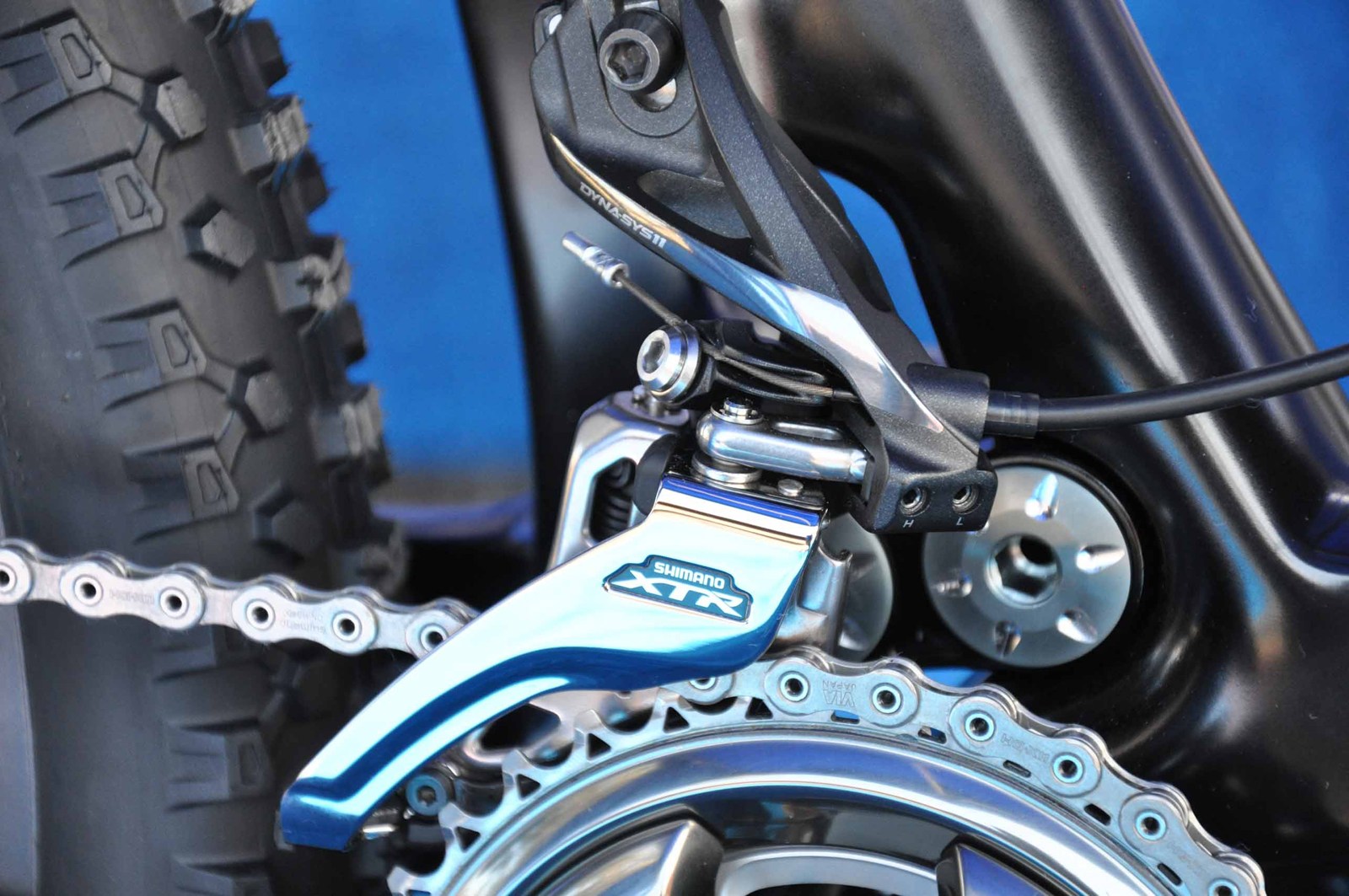
Shimano’s new FD-M9000/M9020 handles the front shifting with a first-ever Side-Swing design that they claim will increase front shift performance by 100 percent. It provides an additional 15mm of rear tire clearance, and the new cable routing comes via the down tube, mellowing cable curves and reducing shifting effort. Options include: The new structure with three mounts: High clamp, Low clamp, D-type, E-type (without plate). A conventional FD-M9025 (double) which they claim increases front shift performance by 50 percent and is available is high and low clamp options.
Front derailleur haters won’t be comforted by the fact that Shimano is still pouring effort into theirs, but everyone else can take heart that the new design is the best FD they’ve ever built (and a good thing, too – if you’re still making a front derailleur these days, it had better kick some serious side-shift ass). It is a new side swing design, which came about as a result of the proliferation of larger wheel sizes and longer travel suspension designs that still call for a front derailleur. It gives 15mm more tire clearance, has a flat inside plate – ostensibly to accommodate a broader chain line but it will also run quieter – and a sweet new cable routing configuration that allows for entry right off the down tube, meaning a smoother cable path and less shift effort.
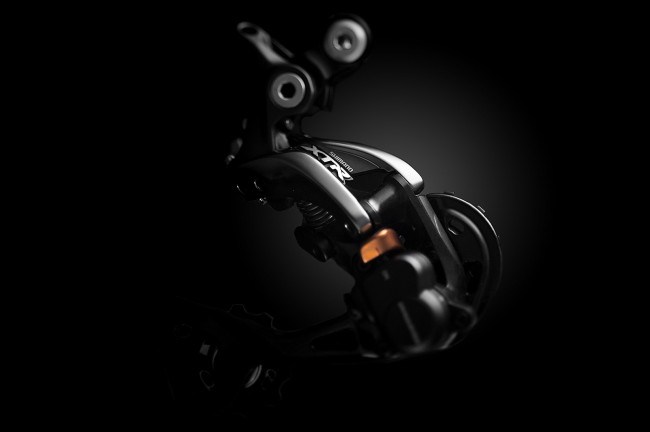
The 2015 XTR RD-M9000 is available in GS (mid cage) and SGS (long cage) options. Shifting promises to be easier and stability while pedaling will also be improved.
As the next generation of the first clutch derailleur, the new rear changer comes from good stock. It sees refinements and tweaks that create better stability and improved shifting due to a repositioned jockey wheel location that sees it riding higher and further forward from the axle than its predecessor. It now has an even lower profile and an easier to adjust clutch tension screw and wider adjustment range – your easy to set up XTR derailleur just got even little better.

Let’s just take another peek at the new RD-9000, shall we? A carbon cage plate and direct mount compatibility help keep weight down.
Like the previous rear derailleur, Shimano’s brakes didn’t require much in the way of design changes. Instead they focused on refinements and added power, heat-dissipation, and reduced weight. An insulated piston and insulated pad coating provide 10 percent more heat resistance. The Race brake’s weight gets a shave due to a magnesium caliper and master cylinder as well as a carbon lever blade. The Trail brake gains power and stiffness from a new Servo-Wave lever with a carbon-alloy structure.
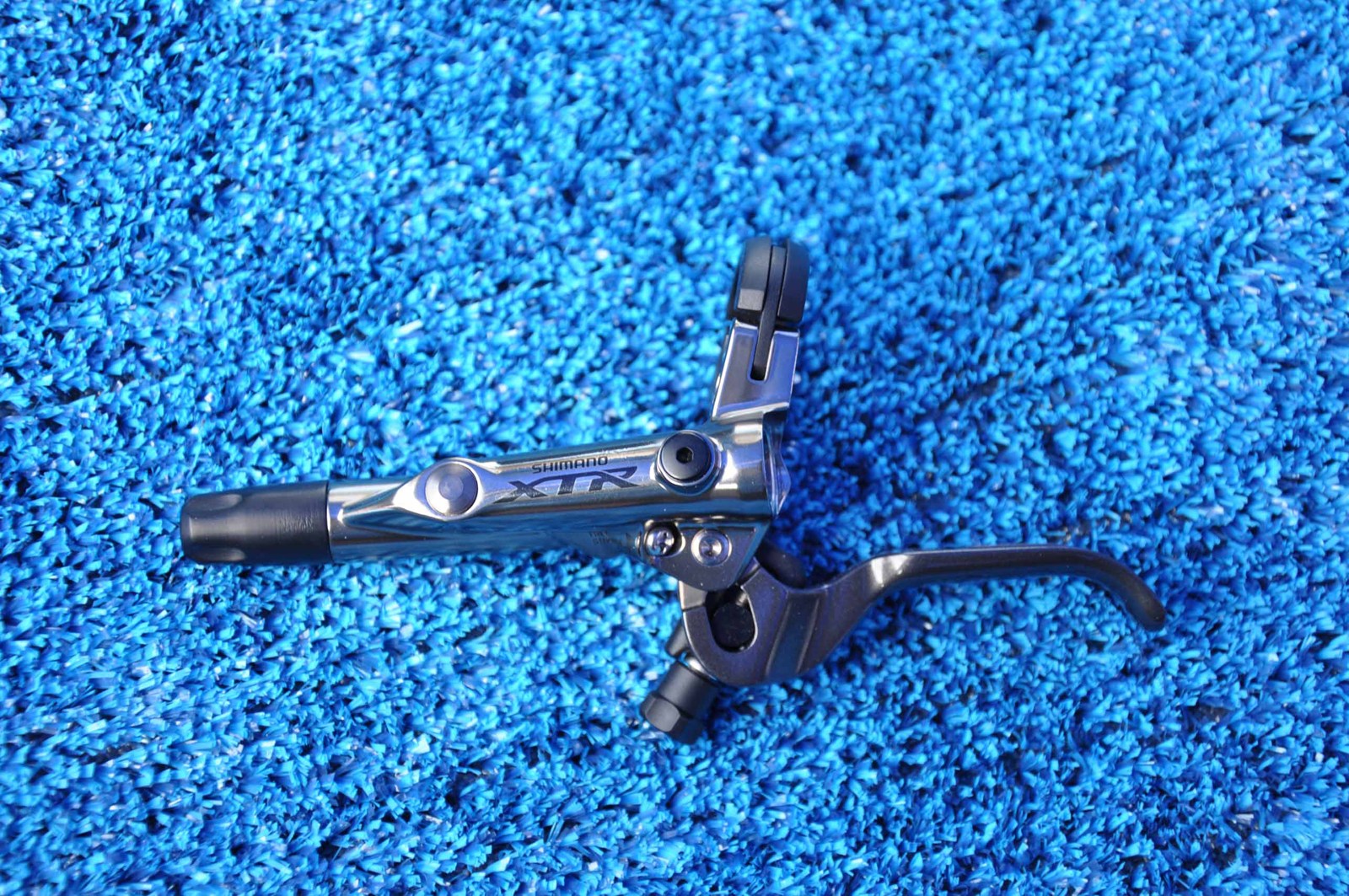
The new XTR Trail brake master cylinder and lever. Not much to improve here. Except stiffness and power.
The rotors with FREEZA tech are now available in smaller sizes (center-lock only) with a lighter weight carbon spider, in 140mm, 160mm, 180mm and 203mm diameter sizes.
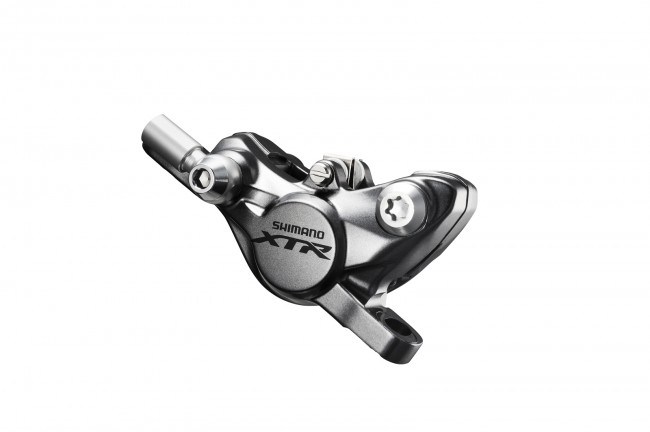
A magnesium caliper and master cylinder, carbon lever blade and titanium mounting bolts all help the Race brake stay svelte without giving up its awesome power.

The Trail brake, complete with the first carbon lever blade Shimano has ever brought to production. Note the narrower bar clamps.
Shimano were also showing some wheels, but the lighting was terrible for photos, so we’ll tell you about ’em and report back when we’ve had a better chance to shoot them. The 2015 XTR wheels feature carbon laminate construction, UST tubeless rims and come in three configurations.
The Race wheels feature a 20mm internal rim width, while the Trail version gets a 24mm rim width, and are said to be a more durable Trail riding option than in the past. For those with smooth legs and fat wallets, there is also a carbon tubular wheel set that will be ultra light and provide astounding traction. All three wheel sets come with 28 spokes front and back. The Race and Trail versions will be made in 27.5 and 29″ versions while the tubulars will only be available in 29″.
So there you have it. Shimano has finally joined the 11-speed fight, and in doing so, has raised some questions about how the modern drivetrain will fit into the way we ride and spec bikes over the next few years.
Did Shimano just land a haymaker?
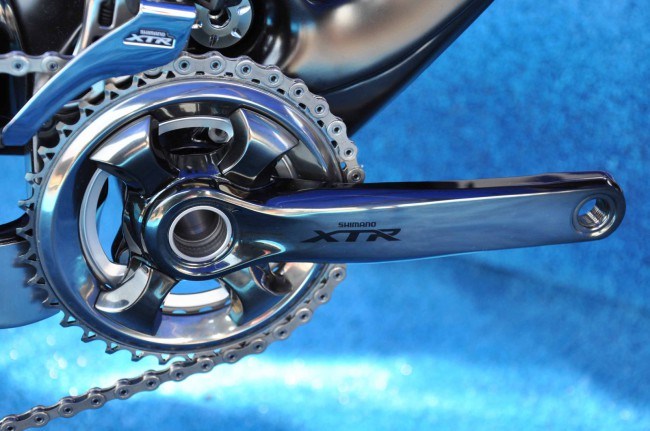









Comments
The Big Picture
10 years ago
Too bad Shimano doesn't go for a mix-master handle bar arrangement. Much neater
Reply
marc
10 years ago
So the 11 speed road cassettes (from both shimano and sram) require a new 11 speed freehub body but the mtb cassettes can use the old 10 speed one? I doubt it. Maybe you should have a closer look at the width of the freehub. I think you'll find it's wider than a 10 speed one by about 2mm (not enough to notice by just looking at it).
Reply
Cr4w
10 years ago
"Great news for all is that CS M9000 eleven-speed cassettes will retrofit to all ten-speed Shimano-compatible freehubs."
If PB says so then it must be true!
http://www.pinkbike.com/news/first-look-2015-shimano-xtr-eleven-speed- cassette-pick-the-drivetrain-of-your-choice.html
Reply
Cr4w
10 years ago
You could run that 11-40 cassette on your 10spd freehub and use a 28t front chainring to get a nearly-1×11 range.
Reply
ashroadadam1 .
10 years ago
Seems more like they're punch-drunk on their swollen self-designated sense of expertise, and they went and made what they felt was perfect in their engineering cocoons, with no thought of the outside world. Expensive proprietary bits that seem to offer few advantages over what people can already assemble on their own. At least we can still mix their brakes into custom groupo without using the nincompoopian crankset hand-carved by gnomes with chainrings made of platinum and gold.
Reply
earle.b
10 years ago
What? It's XTR of course it's going to be expensive, the good news is that Shimano ALWAYS trickles down the the tech all the way to Deore.
Few advantages? I think Pete kinda glossed over the changes to the rear mech, but they reworked it to properly shift with the 40t rear cog. No hacked long B-tension screw and I think it will be pretty safe to presume it will have the well known Shimano crisp shifting across the whole cassette. Look at the main complaint of the cobbled 1x systems and it's the loss of crisp shifting.
Some of us value a true broad gear range and still agree that a 2x system is the better system. The new front mech is going to be great for this.
Reply
Pete Roggeman
10 years ago
By the time I was writing about the RD the article was already Wayyy long. When we review it we'll dig deeper but your comment is accurate - the rear D has some cool refinements that make for a different position through the range. If I can get my hands on the tech images I'll post them up.
Reply
Andy Eunson
10 years ago
Front derailleur routing looks great. Lots of smaller incremental improvements. 11-40 with two by 24-34 could be really nice for how I ride too. Interesting with no 26 wheels available. More indication that 26 size will be abandoned. It will be interesting to see what the DH riders do this year. I am interested too to hear how well their front 1 by ring holds a chain in place. My experience with Shimano suggests damn well.
Reply
Pete Roggeman
10 years ago
A 24×40 gives a shorter gear than a current 22×36, so riders are coming out ahead with the new gear ratios even without a 42.
In XTR product manager Matt Robertson's words last night: "27 is basically 26 anyway…" said facetiously. Sort of. If you look at the wheel releases that have come out this week, anything less than DH is not being considered for 26 anymore, for the most part.
I'm very keen to see how the new chain ring holds the chain as well. No word just yet on when we'll have a test group, but that'll be a key performance indicator.
Reply
Please log in to leave a comment.